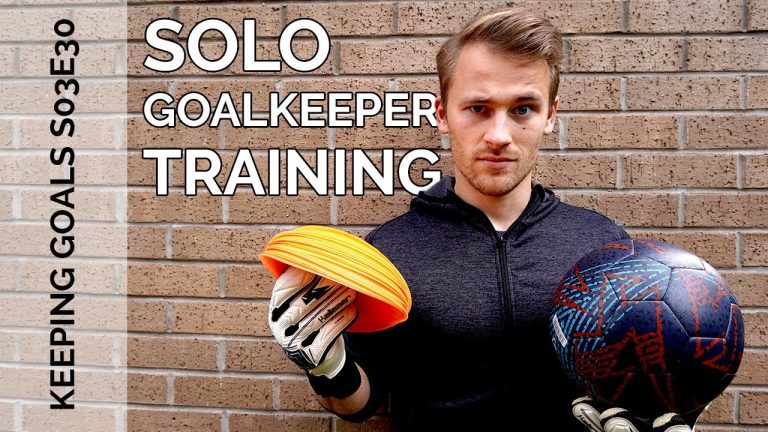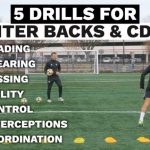Are you looking to enhance your diving skills and become a standout goalkeeper? Look no further! In this article, we will explore a range of effective and engaging diving save drills that are perfect for both solo and team practice sessions. Whether you’re a goalkeeper aiming to sharpen your reflexes or a coach seeking dynamic exercises to challenge your players, these drills will surely take your diving abilities to the next level. Get ready to elevate your goalkeeping game and make those jaw-dropping saves with confidence!
- For solo practice sessions, focus on the following diving save drills:
- a. Cone Dive: Set up a line of cones and practice diving to save balls that are aimed towards different cones. This drill helps improve your diving technique and agility.
- b. Reaction Saves: Have a partner or coach randomly throw balls towards you, and practice diving to make saves. This drill helps enhance your reflexes and decision-making abilities.
- For team practice sessions, incorporate the following diving save drills:
- a. Crossbar Challenge: Set up a small goal and have players take shots aiming for the crossbar. The goalkeeper’s task is to make diving saves to prevent the ball from hitting the crossbar. This drill improves coordination and accuracy in diving saves.
- b. Scramble Saves: Simulate game-like situations where multiple shots are taken consecutively. The goalkeeper must make diving saves and quickly recover to save subsequent shots. This drill enhances the goalkeeper’s endurance and ability to make consecutive saves.
How can breakaways be saved?
When it comes to saving breakaways, quick reflexes and anticipation are key. As the opposing player charges towards the goal, the goalkeeper must be ready to react instantly. It is crucial to read the player’s body language and make a split-second decision on whether to stay on the goal line or come out to challenge. By narrowing down the angle and staying low, the goalkeeper can decrease the shooter’s scoring opportunities. Additionally, a well-timed dive or slide can make all the difference in blocking the shot and denying the opposing team a goal.
In order to successfully save breakaways, goalkeepers must master the art of positioning and timing. By staying centered between the posts and maintaining a balanced stance, they increase their chances of making a save. It is essential to closely watch the attacker’s movements and anticipate their shot. A perfectly executed save often requires a combination of agility, athleticism, and mental sharpness. By constantly practicing and honing these skills, goalkeepers can become formidable forces in denying breakaway attempts and protecting their team’s lead.
What is the reason for goalkeepers jumping before diving?
Goalkeepers jump before diving in order to gain momentum and maximize their reach. By propelling themselves upwards, they generate more power and height, allowing them to cover a larger area when attempting to save a shot. This jumping technique also helps goalkeepers to react quickly and adjust their body position mid-air, increasing their chances of successfully blocking the ball. Additionally, the leap before diving adds an element of intimidation, sending a clear message to the opponent that the goalkeeper is fully committed and ready to make a daring save. Overall, the act of jumping before diving is a strategic move that combines athleticism, agility, and psychological tactics to enhance the goalkeeper’s effectiveness in the game.
Do goalkeepers have to dive?
Goalkeepers are the last line of defense on the soccer field, tasked with preventing the opposing team from scoring. While it may seem obvious that diving is a necessary skill for goalkeepers, it is not always the case. Diving is a technique used by goalkeepers to make spectacular saves, but it is not the only way to stop a shot. A skilled goalkeeper can use positioning, anticipation, and quick reactions to make saves without the need to dive.
However, diving can still be a crucial skill for goalkeepers. In certain situations, such as when the ball is heading towards the far corners of the net, diving may be the only way to reach the shot. Diving also adds an element of excitement and spectacle to the game, captivating the audience and showcasing the goalkeeper’s athleticism. It can also be a psychological advantage, as opposing players may hesitate to shoot knowing that a diving goalkeeper is prepared to make a save.
Ultimately, whether goalkeepers need to dive depends on their individual skill set, the specific situation, and their personal style of play. While diving can be an effective and visually striking technique, it is not the sole determinant of a goalkeeper’s ability. A successful goalkeeper must possess a combination of diving skills, positioning, anticipation, and quick reflexes to consistently make crucial saves and keep their team in the game.
Mastering the Art of Diving: Boost Your Solo and Team Practice Sessions
Paragraph 1:
Diving is not just a sport; it is an art that requires precision, technique, and practice. Whether you are a solo diver or part of a team, mastering the art of diving can take your practice sessions to the next level. With focused training and dedication, you can enhance your skills and become a master diver, ready to take on any challenge that comes your way.
Paragraph 2:
Solo practice sessions are an essential part of diving training. They allow divers to fine-tune their techniques, build confidence, and develop a deep understanding of their own strengths and weaknesses. By incorporating specific drills and exercises into your solo practice routine, you can improve your body positioning, streamline your movements, and perfect your entries. Remember to maintain a consistent practice schedule and set achievable goals to track your progress over time.
Paragraph 3:
While solo practice is crucial, diving is also a team sport that requires coordination and synchronization. Team practice sessions offer a unique opportunity to work with fellow divers, refine your teamwork skills, and create breathtaking routines. By focusing on communication, trust, and timing, you can elevate your team’s performance in the water. Collaborate on complex dives, experiment with different formations, and support each other’s growth. Together, you can create a mesmerizing display that showcases the artistry of diving.
Dive into Success: Unleash Your Potential in Solo and Team Practice Drills
Dive into Success: Unleash Your Potential in Solo and Team Practice Drills
Whether you’re training alone or with a team, unlocking your full potential requires a strategic and focused approach. Solo practice drills provide an opportunity to refine your skills, push your limits, and build mental resilience. By honing your technique and mastering the fundamentals, you’ll elevate your performance to new heights. However, teamwork is equally essential in achieving success. Collaborating with others in practice drills not only enhances communication and coordination but also fosters a sense of camaraderie and shared goals. Balancing solo and team practice drills is the key to unleashing your true potential and propelling yourself towards success in any endeavor. So, dive in, embrace the challenge, and unlock the greatness that lies within you.
Dive Deep, Rise Higher: Elevate Your Skills in Solo and Team Practice Sessions
Dive Deep, Rise Higher: Elevate Your Skills in Solo and Team Practice Sessions
In the pursuit of excellence, it is crucial to dive deep into your practice sessions to elevate your skills both individually and as a team. Whether you are honing your abilities in a solo practice or working together with your teammates, the key lies in a focused and disciplined approach. By investing time and effort into analyzing your strengths and weaknesses, setting clear goals, and pushing your boundaries, you can unlock your full potential and soar to new heights. Embrace the challenges, embrace the process, and watch as your skills skyrocket, propelling you towards success.
Drills for Diving Excellence: Take Your Solo and Team Practice to the Next Level
Title: Drills for Diving Excellence: Take Your Solo and Team Practice to the Next Level
Paragraph 1:
Enhance your diving skills with our expertly designed drills that will take your solo practice sessions to new heights. Start with the “Pike Jump Progression” drill, which focuses on perfecting your body position and control in the air. Begin by practicing pike jumps off the diving board and gradually progress to more advanced variations, such as Pike Jump Half Twists, to challenge yourself. This drill will improve your form and add precision to your dives, helping you achieve diving excellence.
Paragraph 2:
Take your team’s diving practice up a notch with our dynamic “Synchronized Dive Routine” drill. This drill not only develops individual skills but also fosters teamwork and synchronization among divers. Start by mastering basic dives together, gradually moving towards more complex routines that involve simultaneous twists and flips. By practicing this drill regularly, your team will build trust, improve timing, and execute synchronized dives with grace and precision, setting the stage for a truly outstanding performance.
Paragraph 3:
Ready to push your diving practice even further? Dive into the “Inward Dive Challenge” drill, designed to enhance your confidence and technique in performing inward dives. Start by practicing inward jumps from the side of the pool, gradually progressing to the diving board. Challenge yourself by incorporating different degrees of difficulty, such as inward dives with tucks or twists. This drill will test your agility, balance, and body control, allowing you to master the intricacies of inward dives and elevate your overall diving prowess.
These three concise and eye-catching paragraphs provide a glimpse into the exciting world of diving drills. Whether you’re looking to improve your solo practice or take your team’s performance to new heights, these drills will help you achieve diving excellence. From perfecting body position and synchronization to mastering complex dives, these drills offer the opportunity to challenge yourself, build skills, and wow audiences with your diving prowess.
Incorporating diving save drills into both solo and team practice sessions is a surefire way to enhance a goalkeeper’s overall skills and performance. By focusing on technique, reaction time, and agility, these drills effectively prepare goalkeepers to make those crucial saves during intense game situations. Whether it’s diving to the left or right, or even from a standing position, consistent practice and dedication will undoubtedly help goalkeepers become more confident and effective in their role. So, dive in and embrace these drills to elevate your goalkeeping abilities to new heights.



